Introduction
The completion of Roger Mitchell’s course on the Country House in the Twentieth Century marked the end of an epic journey that has lasted for some of our members for five years, as the development of the country house in England has been explored since the Middle Ages. Roger’s enthusiasm, manner of presentation and scholarship have a way of bringing the past vividly to life and that past has included many aspects of social life as well as architecture. The twentieth century sequence brought up the key issue of balancing heritage with democracy, in which the National Trust has played a significant part. We are most grateful to Roger for providing a most stimulating and enlightening experience. For newer members who missed the earlier courses, he hopes to produce an abridged version, and he has plans for a short course on Tudor and Stuart Country Houses in the summer of 2023.
The next meeting of SUES members is on Monday 25th April at 10.30 am at All Saints Church Hall. A reminder of the details is provided below. Alan will soon be in touch with those who have registered. Further registrations are still possible.
At the moment much of the work of the committee is in looking to the future. We are working on an expanded programme for 2022-3 with an increased number of lectures and multi-session courses of varying length.
This edition of Forum contains articles by Christine Vasey and Mary Ormsby. The former introduces us to a remarkable man who managed to be a road engineer despite being blind. Mary extends her Scarisbrick interest to its connection with a medical man of national significance. We also provide a follow-up to Peter Firth’s piece on anagrams.
The Secret Life of the Human Brain
Course to be delivered by Dr Alan Potter on Apr 25, May 2, 9, 16, 23, 30, June 6 (7 sessions course fee £35).
Over the centuries, and despite being essential for life, the workings of the brain have often remained a mystery. Scientific study and dissection provided some evidence, but it is only now through modern techniques, including therapy and surgery, and instruments such as MRI scanners, that we more fully understand the brain and can truly wonder at what it achieves.
Using up-to-date research, illustrations and images, this course uncovers the origin of the brain, describes the functions of each part and demonstrates how they connect with each other and the whole body to provide a sophisticated driving force. In this way, common myths about the brain will be debunked and advice shared on how, as we get older, we can keep it healthy, happy and active.
The Scarisbrick Story
Mary Ormsby’s interest and expertise in Scarisbrick Hall and its family has been demonstrated on a number of occasions. It was particularly interesting, therefore, to hear her draw many of the strands together in her recent Friday afternoon talk to members. This was part one of an account of the Scarisbrick family, dating back to the early Middle Ages. As is so often the case with such families the vagaries of inheritance have produced many curious characters and episodes. The role of Thomas Eccleston in the Agricultural Revolution was especially intriguing. SUES is lucky to have such an expert on local history amongst its members and one who can share that interest so effectively.
Blind Jack of Knaresborough
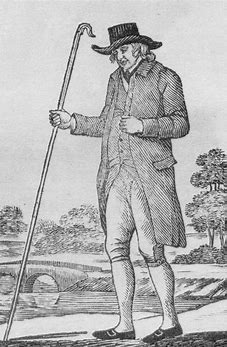
The delightful Yorkshire spa town of Knaresborough has a lot to offer the visitor; a picturesque location above the River Nidd, a splendid viaduct, a ruined Norman castle where the four knights who murdered Thomas Becket in Canterbury Cathedral in 1170 went into hiding after they fled the scene of their crime and also one of England’s oldest tourist attractions, Old Mother Shipton’s Cave next to the Petrifying Well, which opened to the public in 1630. Visitors are still fascinated by the sight of diverse objects, teddy bears, handbags, gloves and ladies’ underwear suspended on a wire and slowly turning to stone as the spring water drips down upon them.
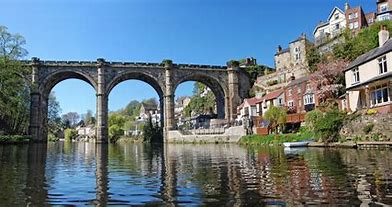
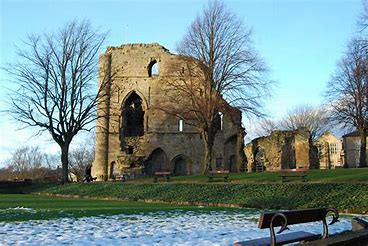
We can’t mention Knaresborough without a brief reference to Ursula Southiel, or Old Mother Shipton as she is better known, born in 1488 and believed by many to be a witch. She was renowned for her love potions and herbal remedies but retrospectively, her greatest claim to fame was as a prophetess who foretold with remarkable accuracy, the Dissolution of the Monasteries, the Great Plague of 1665 and the Great Fire of London, 1666. Sadly, her vision did not extend much beyond the 17th century and her most famous prophecy “The world to an end shall come in eighteen hundred and eighty-one” turned out to be a forgery. There is a statue of Old Mother Shipton sitting on a bench in the market square in Knaresborough. Certainly, a much more attractive version of her than her usual depiction of her as a scary witch! On another bench nearby is a statue of a fellow resident of the town who deserves to be just as famous as Old Mother Shipton, if not more so.
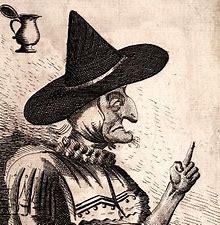
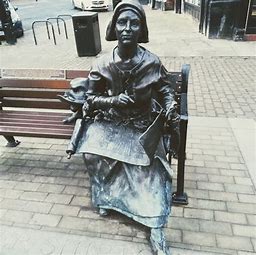
We have all heard of Thomas Telford and John McAdam but probably not of John Metcalf, also known as Blind Jack of Knaresborough, who richly deserves to be included in the great pantheon of road builders. This intrepid pioneer was born into a family of horse dealers in 1717. At the age of six, Jack contracted smallpox and as a result, lost his sight. He was encouraged to play the fiddle so as to be able to earn a living and as a young man he entertained the regulars in the taverns of Harrogate. He never let his visual impairment hold him back from enjoying life to the full. He was an excellent swimmer and horseman and he loved hunting, cock fighting and playing cards. Jack knew the local area so well that he acted as a tourist guide, and he even tried his hand at smuggling. He also had an eye for the ladies and fathered at least one illegitimate child, which caused a local scandal, before he eventually eloped with Dolly Benson, an innkeeper’s daughter and not the mother of the illegitimate child. After he married, Jack set up a business transporting fish from Whitby to Leeds and Manchester and so began his involvement with roads, but it was another 20-odd years before this became the major focus of his life.
In 1745, Bonnie Prince Charlie landed in Scotland intent on pursuing his claim to the English throne and the Highlanders flocked to his banner. Jack, a staunch supporter of the House of Hanover, was involved in recruiting men for the Yorkshire Blues and went with the regiment to Scotland as a military musician and, playing a brisk tune on his pipe, led a column of infantry into battle. He was actually taken prisoner but managed to persuade his captors to let him go, for as a blind man he claimed, he could do no harm to anybody. He was present at the Battle of Culloden in 1746 when the Duke of Cumberland’s Redcoats routed the Jacobites. Jack was very impressed by the 250 miles of military roads built before and during the campaign by General Wade to ensure the swift deployment of men and equipment into the remote heart of the Highlands.
Returning to Yorkshire as something of a hero, Jack developed a stagecoach route between York and Knaresborough, He drove the stagecoach himself, making two trips a week. The roads in England at this time were the responsibility of the local parishes through which they passed and they were generally in a terrible condition. Jack knew, from personal experience, just how bad they were! In 1765, in an attempt to remedy the situation, Parliament authorized the creation of turnpike roads funded by tolls and Jack won a contract to build a three-mile section of toll road between Harrogate and Boroughbridge. Alone with his viameter, or surveyor’s wheel, Jack explored the terrain and worked out the most practical route. This was the beginning of his illustrious career in civil engineering. Jack, completely self-taught, believed that firm foundations and proper drainage were the secrets of good road making. Altogether, Jack constructed about 180 miles of turnpike road mostly in Yorkshire but also in Lancashire, Cheshire and Derbyshire. His most ambitious achievement was the road from Huddersfield to Manchester over the Pennines. He employed a loyal workforce of 400 men and he would arrive on site at six in the morning and walk every section of the road tapping it with a hollow stick to test its quality. He finally retired in his 70s to the village of Spofforth near Harrogate. At the age of 77, he walked from Spofforth to York to dictate a detailed account of his adventurous life to a publisher. The resulting book was a bestseller. Jack died in 1810 at the age of 92. He left four children, twenty grandchildren and ninety great-grandchildren. In Knaresborough market-place, outside the inn, which bears his name, you can see the statue of Jack holding his surveyor’s wheel; the original of which is now in the local museum. It is somewhat over fanciful to imagine that as the statues of Old Mother Shipton and Jack are so near each other, they perhaps exchange a few words once all the tourists have gone. How fascinating it would be to eavesdrop on their conversation! Jack is buried in All Souls Church in Spofforth and his headstone bears this epitaph:
Here lies John Metcalf, one whose infant sight
Felt the dark pressure of an endless night;
Yet such the fervor of his dauntless mind,
His limbs full strung, his spirit unconfined,
That long ere yet life’s bolder years began,
The sightless efforts mark’d the aspiring man;
Nor marked in vain – high deeds his manhood dared,
And commerce, travel both his ardour shared.
T’was his a guide’s unerring aid to lend-
O’er trackless wastes to bid new roads extend;
And when rebellion reared her giant size,
T’was his to burn with patriot enterprise;
For parting wife and babes, one pang to feel,
Then welcome danger for his country’s weal.
Reader, like him, exert thy utmost talent given!
Reader, like him, adore the bounteous hand of Heaven.
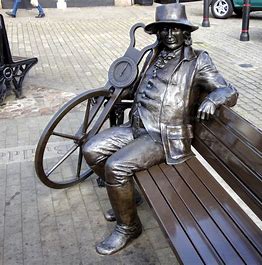
Christine Vasey
William Moorcroft – England’s First Trained Veterinary Surgeon and the Scarisbrick Connection
William Moorcroft was born in Ormskirk in 1676, the illegitimate son of Ann Moorcroft. Luckily Ann’s parents Richard Moorcroft and his wife Dorothy nee Prescott had fairly substantial land holdings in and around Ormskirk and William was brought up in his grandfather’s home. Richard and Dorothy were committed to dairy farming, so William grew up surrounded by livestock. In fact, one of his earliest memories was of riding on his grandfather’s knee around his estate.
We know nothing of his education, whether he was sent off to school, educated at the local grammar school or one of the private schools then in the town. He did benefit from the fact his grandfather was a wealthy, educated man with many social contacts.
One of Richard’s friends and neighbours was Thomas Eccleston (son of Basil Thomas Scarisbrick) who came to manage the Scarisbrick estate in 1778. Both Richard and Thomas were very active in the fields of scientific farming and agricultural improvement. Thomas Eccleston experimented widely in horse and cattle breeding, in manures, crops and machinery so that several times in his notebook he claims to be “the first ever in this county”.
Eccleston seems to have treated William as a son, despite having several children of his own. William later referred to him as “my more than father”. He spent many days at Scarisbrick and Eccleston fostered in him a love of land and its management. Through Eccleston, William met John Gilbert, the Duke of Bridgewater’s canal engineer, Robert Bakewell a great stock breeder and Henry Aston another stockbreeder. William later described himself as Aston’s protégé and friend.
Thomas Eccleston, Henry Aston and Richard Moorcroft, three wealthy men supported William giving him affection, connections and probably considerable sums of money. However, William’s mother had married and had a further two children, so Richard’s first priority in settling his estate was to care for Ann’s future, so he left only money for William.
With no land to inherit William needed a career which would allow him to support himself in comfort. One such career was surgery. Having decided on surgery William could either have attended a university medical school or apprenticed himself to a local surgeon. Eccleston was a financial supporter of the Liverpool Infirmary and Dr Joseph Brandreth an Ormskirk man practised there, so he chose the latter option. Sometime in the early 1780s William became apprenticed to John Lyon, a surgeon, with whom he lived and worked at the Liverpool Infirmary.
Surgery was crude and not for the faint hearted or the weak. These were the days before anaesthetics and antibiotics. Human surgery was literally in the ‘stone age’. Dr John Lyon had trained in London and by the time William knew him had amassed quite a fortune. He was a Christian and a kind and warm hearted man whom William came to love.
Lyon was impressed by his young pupil and suggested he broaden his experience by training in London or the continent, but fate intervened In October 1788. Thomas Eccleston experienced the sudden death of a long horn heifer, followed swiftly by two more. Ever a man of science Thomas sent for the help of his medical friends at Liverpool Dr Brandreth and Dr Lyon – they sent William.
He was unable to save the animals but made records, conducted a detailed post mortem on one animal and prevented a wider outbreak by insisting the dead animals were buried at least “4 yards deep” underground. Moorcroft knew they were lucky to have avoided a major catastrophe.
The need for a veterinary school in England was a cause close to Thomas Eccleston’s heart. He knew of the one in Copenhagen and the two in France. After the event described above Eccleston and perhaps William’s grandfather and Henry Aston began to suggest to William the possibility of him training to be a vet. Eccleston asked “Could any reward be too great for a preventative cure of that fatal disorder of which so many thousands of animals die annually in this kingdom?” They would never get a cure, he continued, owing to the ‘ignorance of cow doctors in their disorders’. What was needed he claimed was a veterinary school.
This required a practical educated person who loved and had grown up with animals and had a thorough scientific and medical training to devote himself to the reform of animal medicine. Many years later Moorcroft remembered his feelings at this turning point in his life. ‘ If I were to devote myself to the improvement of a degraded profession, closely connected with the interests of agriculture, I might render myself more useful to the country, than by continuing on one already cultivated by men of the most splendid talents”.
Eccleston and Richard, William’s grandfather planned to send William to the veterinary school at Lyon, but prior to this he went to London to broaden his experience working with animals. Moorcroft’s letters to Eccleston indicate that Eccleston had a two-fold relationship with William: from a position of being a few years older than William and an established and successful landowner. He was a good sounding board and financially he was able to be a patron. Whilst most of the costs of his time at Lyon were born by Richard Moorcroft, Thomas Eccleston also seems to have helped financially.
Moorcroft returned to London in 1792 eventually obtaining extensive premises in Oxford Street. He became a highly successful horse doctor in London with an extensive and well-connected clientele, until in 1808 he was offered a post to work for the East India Company at a salary pf £3000 p.a. an enormous sum at the time. In India William became a significant traveller and explorer, never returning from the sub-continent
Sources
Thomas Eccleston: A Progressive Lancastrian Agriculturalist – John M Virgoe
Beyond Bokhara: The Life of William Moorcroft, Asian Explorer and Pioneer Veterinary Surgeon – Gary Alder
Mary Ormsby
The Crazy World of Anagrams – The Answers
How well did you do? At the end of my article in FORUM 28, I set a short test to see how many anagrams you could come up with from ten words. Below are the answers. It was meant as a fun exercise but, for those with a more competitive approach, I also suggested a time limit. In nearly every case, there are more anagrams than I set, although some may be unfamiliar to you – another benefit of anagrams, namely, expanding our vocabulary.
The most difficult one, I feel, was carthorse; I left it till last. So, don’t be surprised, if you didn’t solve that one. Most people won’t have. If you did, award yourself a Gold Star!
In the section where I showed how anagrams can sometimes change a proper noun or personal name into an appropriate sentence, one of our members came up with a potentially more applicable answer.
Where I had changed Margaret Thatcher → Meg, the arch tartar, an alternative was provided: That great charmer! I leave you ponder on which anagram is more fitting! Meantime, many thanks for this contribution to the crazy world of anagrams. Any other feedback is always welcome.
2 from ear, 20 secs = are, era, rea
2 from care, 20 secs = race, acre, acer
2 from asleep, 20 secs = please, elapse, sapele
2 from counter, 30 secs = recount, trounce, cornute
4 from star, 30 secs = tsar, rats, tars, arts
4 from crate, 30 secs = cater, trace, react, carte, caret, recta
3 from canter, 30 secs = trance, recant, nectar, carnet, centra, tanrec
5 from crates, 45 secs = caters, traces, reacts, recast, caster, carets, cartes
4 from prose, 45 secs = ropes, pores, spore, poser, repos
1 from carthorse, 60 secs = orchestra
Peter Firth
Contacts
Chair: Alan Potter
alanspotter@hotmail.com
07713 428670
Secretary: Roger Mitchell
rg.mitchell@btinternet.com
01695 423594 (Texts preferred to calls)
Membership Secretary: Rob Firth
suesmembers74@gmail.com
01704 535914
Forum Editor: Chris Nelson
chris@niddart.co.uk
07960 117719
Facebook: facebook.com/groups/southportues
See our archive for previous editions of the SUES Forum!